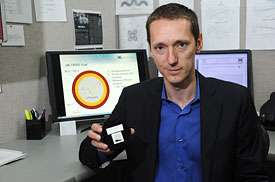Researcher uses code to test nuclear fuels

When friends ask Idaho National Laboratory researcher Blaise Collin what his job entails, he compares his scientific simulation work to operating a flight simulator.
"When you use a flight simulator, you're not actually flying a plane. But the system allows you to mimic flight and to change the conditions; for instance, to add more wind," Collin explains. "Then, you can use what you've discovered from these simulations to build better and safer planes."
In a similar way, Collin uses mathematical models and runs codes to simulate hypothetical experiments under a variety of conditions. The data he gathers is then used to advance scientific understanding and, in regard to his work at INL, to facilitate searches for safer technology.
Collin's experience with scientific modeling and simulation is extensive and varied: prior to joining INL, he modeled and simulated a German-French nuclear physics experiment to probe the electromagnetic structure of the proton, designed a model to help with the detection of cosmic neutrinos in Antarctica, and developed codes to simulate French nuclear company AREVA's nuclear reactors. In his current position, Collin works with software called PARFUME (particle fuel model) as part of an effort to find new, safer fuel sources for use in nuclear reactors.
In particular, TRISO (tristructural isotropic) fuel is specially designed with multiple coating layers surrounding the fissile material. These layers retain fission products produced during the nuclear reaction. The fuel is of great interest within the international nuclear community and is a major focus of developmental efforts by INL and the U.S. Department of Energy. This work is part of an international effort to enter a new generation (Generation IV) of nuclear technology that aims to improve the safety and efficiency of nuclear reactors.
Although enormous gains are being made, further research is still needed before TRISO fuel can be used commercially. As a leading researcher for the current TRISO fuel development effort in the United States, Collin uses PARFUME to predict the behavior of TRISO fuel under a variety of conditions within Very High Temperature Reactors, which are designed to use it.
As researchers perform experiments on TRISO fuel, Collin and his colleagues use the resulting data to refine the PARFUME code, making it more accurate. Engineers can then employ the software to predict a growing number of nuclear reactor scenarios with increasing accuracy. Before scientists perform numerous costly physical experiments testing the capabilities of proposed fuels, Collin and his colleagues can use the code to determine the likely outcome. In the field of nuclear research, computer modeling and simulation allow researchers to save critical amounts of both time and money.
"Blaise's work with PARFUME is important both internationally and nationally," Collin's manager, Robert Mariani, says. "It's important internationally because TRISO fuel has long received attention from worldwide research institutions. It's important nationally because Blaise enhanced the PARFUME software to help scientists at Oak Ridge National Lab in evaluating a novel accident-tolerant fuel concept."
The accident-tolerant fuel concept Mariani refers to is called uranium nitride (or "UN") TRISO fuel. It is particularly novel as the first application of TRISO fuel for Light Water Reactors, the most predominant electricity-generating reactors in the world today. The concept of TRISO-coating gives the proposed fuel a high tolerance to potential accidents because of its high retention of fission products. Uranium nitride is suggested as fissile material because it offers more energy per unit volume compared to conventional TRISO fuel.
Although PARFUME was not originally created to be used with Light Water Reactor systems, Collin adapted the model in order to assist a team of Oak Ridge researchers in their studies on the feasibility of UN TRISO fuel. He used the adapted model to investigate the behavior of UN TRISO fuel under normal reactor conditions. Collin also assessed the fuel's sensitivity to key irradiation parameters such as fuel temperature, how much neutron flux the fuel receives over time, and the fraction of the fuel that undergoes fission. Fuel characteristics including dimensions and mechanical strength were evaluated as well.
Collin's PARFUME adaptation allowed for testing that eliminated costly experimentation and provided Oak Ridge researchers with useful data on UN TRISO fuel behavior under Light Water Reactor conditions. Furthermore, Collin's adjustments expanded the applicability of the PARFUME code and opened the door to faster, more efficient research into safer Light Water Reactor fuel sources.
As a result of the modeling effort that Collin and others perform at INL, nuclear researchers can deepen their understanding of observed behavior. They can also save time and money by identifying experiments that produce crucial and meaningful results. The use of modeling and simulation is an indispensable part of the U.S. effort to produce safer, more efficient nuclear power plants for domestic energy uses.
"Modeling and simulation is describing and explaining observed physical phenomena and predicting the outcome of new phenomena, in both a cost and time-efficient way," Collin says. "Our modeling and simulation activities can play a significant role in meeting future U.S. energy needs."
Provided by Idaho National Laboratory





















